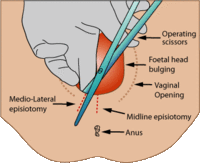
Photo from wikipedia
Purpose To compare intra- and postoperative outcomes between the standard linear incision technique with tissue preservation (LITT-P) and the minimally invasive star-shaped incision (SSI). Study Design A retrospective cohort study.… Click to show full abstract
Purpose To compare intra- and postoperative outcomes between the standard linear incision technique with tissue preservation (LITT-P) and the minimally invasive star-shaped incision (SSI). Study Design A retrospective cohort study. Methods Primary outcomes evaluated operative time, implant survival, and intra-operative complications. A secondary outcome evaluated soft tissue tolerability assessed by the Holger's classification. Results A total of 38 implants were placed (19 LITT-P; 19 SSI). The median and mean surgical duration for the LITT-P group was statistically shorter than the SSI group (p = 0.0001). No intra-operative complications were reported for both surgical approaches. Five implants were lost during postoperative follow-up: one in the LITT-P and four in the SSI cohort. Both cohorts showed favorable soft tissue tolerability. Less Holgers 1 and 2 and more Holgers 3 soft tissue reactions were observed after the LITT-P compared to the SSI. Conclusion The novel SSI approach could be an alternative option based on the theoretical benefits and found favorable (and similar) soft tissue outcomes. Implant loss and surgical time are aspects to investigate regarding long-term durability and warrant further research.
Journal Title: Frontiers in Surgery
Year Published: 2022
Link to full text (if available)
Share on Social Media: Sign Up to like & get
recommendations!